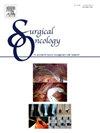Natural history of salivary gland secretory carcinoma: A REFCOR study.
IF 2.4
4区 医学
Q3 ONCOLOGY
引用次数: 0
Abstract
Background and objectives
Salivary gland Secretory Carcinoma (SC), characterized by Skalova in 2010 is a rare tumor studied within the REFCOR (French Network of experts on Rare Head and Neck Cancers). We conducted a prospective multicentric cohort study of 108 SC cases in the REFCOR database up to July 2021, analyzing diagnostic, therapeutic, and survival data.
Methods
Data was collected prospectively from diagnosis to the last update. Each patient had two histological readings including one by a REFCORpath pathologist, and all cases underwent molecular testing to confirm diagnosis. Statistical analyses were performed using R software.
Results
MRI was not contributive to malignancy diagnosis. After 2 histological readings, 79 % of patients were diagnosed, with 21 % requiring molecular testing to confirm diagnosis. Surgical treatment typically involved tumor excision and lymph node dissection. The tumor exhibited low lymph node involvement, with 95 % of patients being cN0, and no nodal metastases post-dissection. Five-year overall survival and recurrence-free survival were 91.4 % {95 % CI (0.84–1)} and 89 % {95 % CI (0.81; 0.98)} respectively, indicating a favorable prognosis.
Conclusions
SC is a rare and newly recognized tumor, with generally favorable outcomes. Our cohort, among the largest to date, provides valuable insights. Future research should refine treatment guidelines.
涎腺分泌性癌的自然史:REFCOR 研究。
背景和目的涎腺分泌性癌(SC)是一种罕见肿瘤,2010 年由 Skalova 定性,在 REFCOR(法国罕见头颈部癌症专家网络)范围内进行研究。我们对 REFCOR 数据库中截至 2021 年 7 月的 108 例 SC 病例进行了前瞻性多中心队列研究,分析了诊断、治疗和生存数据。每位患者都有两次组织学检查,其中一次由REFCORpath病理学家进行,所有病例都进行了分子检测以确诊。统计分析使用 R 软件进行。经过两次组织学检查后,79%的患者被确诊,21%的患者需要进行分子检测才能确诊。手术治疗通常包括肿瘤切除和淋巴结清扫。肿瘤的淋巴结受累程度较低,95%的患者淋巴结受累程度为cN0,切除后无结节转移。五年总生存率和无复发生存率分别为 91.4 % {95 % CI (0.84-1)} 和 89 % {95 % CI (0.81; 0.98)},预后良好。我们的队列是迄今为止规模最大的队列之一,提供了有价值的见解。未来的研究应完善治疗指南。
本文章由计算机程序翻译,如有差异,请以英文原文为准。
求助全文
约1分钟内获得全文
求助全文
来源期刊

Surgical Oncology-Oxford
医学-外科
CiteScore
4.50
自引率
0.00%
发文量
169
审稿时长
38 days
期刊介绍:
Surgical Oncology is a peer reviewed journal publishing review articles that contribute to the advancement of knowledge in surgical oncology and related fields of interest. Articles represent a spectrum of current technology in oncology research as well as those concerning clinical trials, surgical technique, methods of investigation and patient evaluation. Surgical Oncology publishes comprehensive Reviews that examine individual topics in considerable detail, in addition to editorials and commentaries which focus on selected papers. The journal also publishes special issues which explore topics of interest to surgical oncologists in great detail - outlining recent advancements and providing readers with the most up to date information.
 求助内容:
求助内容: 应助结果提醒方式:
应助结果提醒方式:


